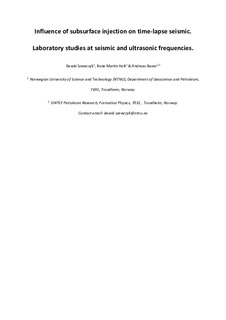| dc.contributor.author | Szewczyk, Dawid | |
| dc.contributor.author | Holt, Rune Martin | |
| dc.contributor.author | Bauer, Andreas | |
| dc.date.accessioned | 2019-01-16T07:07:20Z | |
| dc.date.available | 2019-01-16T07:07:20Z | |
| dc.date.created | 2018-05-22T09:47:15Z | |
| dc.date.issued | 2018 | |
| dc.identifier.citation | Geophysical Prospecting. 2018, 66 99-115. | nb_NO |
| dc.identifier.issn | 0016-8025 | |
| dc.identifier.uri | http://hdl.handle.net/11250/2580770 | |
| dc.description.abstract | Seismic monitoring of reservoir and overburden performance during subsurface CO2 storage plays a key role in ensuring efficiency and safety. Proper interpretation of monitoring data requires knowledge about the rock physical phenomena occurring in the subsurface formations. This work focuses on rock stiffness and elastic velocity changes of a shale overburden formation caused by both reservoir inflation induced stress changes and leakage of CO2 into the overburden. In laboratory experiments, Pierre shale I core plugs were loaded along the stress path representative for the in situ stress changes experienced by caprock during reservoir inflation. Tests were carried out in a triaxial compaction cell combining three measurement techniques and permitting for determination of (i) ultrasonic velocities, (ii) quasistatic rock deformations, and (iii) dynamic elastic stiffness at seismic frequencies within a single test, which allowed to quantify effects of seismic dispersion. In addition, fluid substitution effects connected with possible CO2 leakage into the caprock formation were modelled by the modified anisotropic Gassmann model. Results of this work indicate that (i) stress sensitivity of Pierre shale I is frequency dependent; (ii) reservoir inflation leads to the increase of the overburden Young's modulus and Poisson's ratio; (iii) in situ stress changes mostly affect the P‐wave velocities; (iv) small leakage of the CO2 into the overburden may lead to the velocity changes, which are comparable with one associated with geomechanical influence; (v) non‐elastic effects increase stress sensitivity of an acoustic waves; (iv) and both geomechanical and fluid substitution effects would create significant time shifts, which should be detectable by time‐lapse seismic. | nb_NO |
| dc.language.iso | eng | nb_NO |
| dc.publisher | European Association of Geoscientists and Engineers (EAGE) | nb_NO |
| dc.title | Influence of subsurface injection on time-lapse seismic: laboratory studies at seismic and ultrasonic frequencies | nb_NO |
| dc.type | Journal article | nb_NO |
| dc.type | Peer reviewed | nb_NO |
| dc.description.version | acceptedVersion | nb_NO |
| dc.source.pagenumber | 99-115 | nb_NO |
| dc.source.volume | 66 | nb_NO |
| dc.source.journal | Geophysical Prospecting | nb_NO |
| dc.identifier.doi | 10.1111/1365-2478.12606 | |
| dc.identifier.cristin | 1585831 | |
| dc.relation.project | Norges forskningsråd: 234074 | nb_NO |
| dc.description.localcode | This is the peer reviewed version of an article, which has been published in final form at [https://doi.org/10.1111/1365-2478.12606]. This article may be used for non-commercial purposes in accordance with Wiley Terms and Conditions for Self-Archiving. | nb_NO |
| cristin.unitcode | 194,64,90,0 | |
| cristin.unitname | Institutt for geovitenskap og petroleum | |
| cristin.ispublished | true | |
| cristin.fulltext | postprint | |
| cristin.qualitycode | 1 | |
